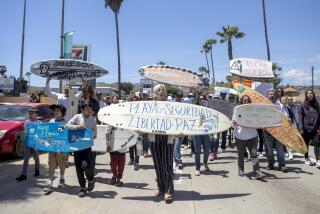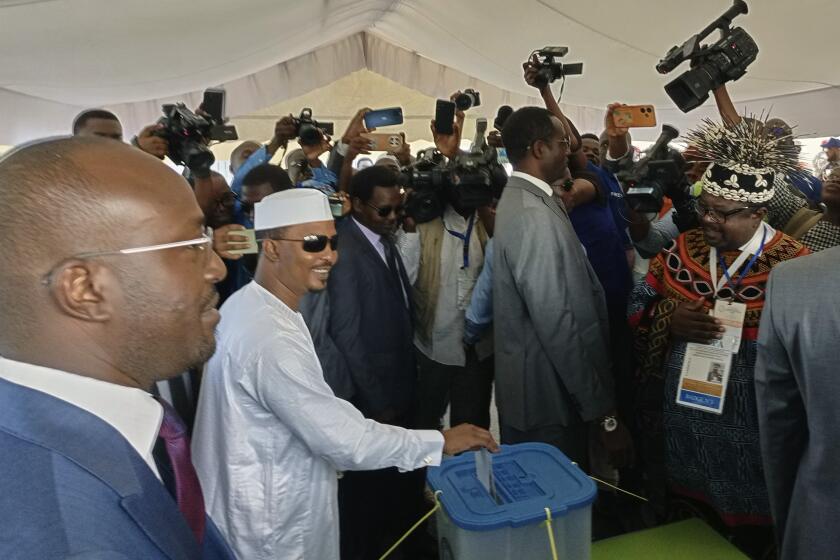Tractors Crush Heart of a Nation
At one time, Jose Aogua’s ancestors could gaze out to the distant horizon, across miles of verdant savanna, and still not see the limit of their land. The hunt was plentiful and the rivers stocked with fish, so much so that Aogua’s Bororo tribe developed elaborate religious rituals to celebrate nature’s bounty.
Then the Portuguese frontiersmen came on horseback to battle Indian tribes and lay claim to ever-larger chunks of their historic lands. Now the interlopers arrive on tractors and combines, their relentless advance threatening the Bororo and other indigenous peoples of Brazil.
An agricultural explosion is underway in this mammoth country, transforming the world’s ninth-largest economy into a farming, logging and ranching powerhouse able to compete with the U.S. and Europe in the production of everything from beef to orange juice.
But the rapid expansion is exacting an anthropological toll not unlike that of the American push west during the 19th century. Land is being cleared and cultivated at a galloping rate, especially for soy, Brazil’s new blockbuster crop. As a result, native peoples have been squeezed onto tiny reservations where their customs and traditions are in danger of dying from obsolescence or environmental destruction.
“The indigenous areas are islands surrounded by soy and ranching,” said Mario Bordignon, a historian and advocate for the indigenous. “They used to be nomads, but now they have nowhere to roam.”
In May, the plight of Brazil’s Indians garnered worldwide attention when loggers encroached on a small, previously uncontacted tribe on the edge of the Amazon rain forest. The judge who had opened the area to loggers hastily reversed course following an outcry by Brazilian officials and international activists, who warned that the isolated community could face annihilation.
The tribe lives on the northern fringe of Mato Grosso state, which also happens to be the engine of Brazil’s spectacular growth as an agribusiness giant over the last several years.
A vast and ecologically diverse area in the heart of the South American continent, Mato Grosso boasts rain forest to the north and the world’s largest wetland, the Pantanal, in the south, home to hundreds of rare animal species. In between lies the fertile savanna coveted by farmers and ranchers.
Their interests, however, have inevitably collided with those of many of the three dozen indigenous tribes scattered across the state and also with environmentalists. Almost half of the deforestation last year in the Brazilian Amazon occurred here in Mato Grosso, as loggers moved in to harvest prime woods, with farmers and ranchers hard on their heels.
The speed and thoroughness of land-clearing in Mato Grosso, Brazil’s top soy-producing state, have caught many of the native peoples by surprise.
“They’re alarmed because the white men chop down everything,” Bordignon said. “They feel that the white men are worse than animals because they destroy everything.”
Government restraints on agricultural expansion at the expense of the environment have been negligible or relatively unenforced, which may not be surprising given that the governor of Mato Grosso, Blairo Maggi, heads the Maggi Group, the world’s largest soybean producer, which grossed $600 million last year.
In light of the new deforestation figures, Maggi said last month that he would propose a three-year moratorium on development in his state. But critics are skeptical of a man once quoted as saying, “To me, a 40% increase in deforestation doesn’t mean anything at all, and I don’t feel the slightest guilt over what we are doing here.”
Jose Carlos Dias, the governor’s communications secretary, insisted that Maggi’s administration fully upheld the laws restricting development in such areas.
“Fourteen percent of Mato Grosso is indigenous land and is occupied by Indians,” he said. “The state government does not interfere in the lives of the indigenous. The government of Mato Grosso is in full compliance with the law.”
Aogua, a Bororo elder here in the village of Corrego Grande, is unimpressed by such assurances.
The last remaining 1,300 Bororo are confined to six officially designated pockets of land in Mato Grosso, totaling about 500 square miles. That, they say, is but a fraction of what was granted them by Candido Mariano da Silva Rondon, a famed expeditionary of the late 19th century, in documents that still exist.
“We don’t live in the area that Rondon left us,” said Aogua, 61. “The farmers came and took some, cattle moved in, the fences were moved, and the land got smaller and smaller and wound up like it is now.”
His village is home to about 340 people who live in a world of contrasts. A satellite dish sits nestled among thatched homes and communal toilets. Bevies of youngsters cluster around the concrete and wood school with its paved mini-soccer pitch, while chickens, dogs and a few impossibly colored macaws scuff and squawk in the dirt.
Certain Bororo traditions are still observed, such as tribal meetings in the central building and initiation rites for boys who come of age.
More difficult now are ancient ceremonies involving fishing and hunting. Both fish and game have been ravaged by land-clearing around the village, some of it by a soy farmer who the Bororo say has infringed on their territory. Several years ago, pesticides from the farm killed many of the fish in the river.
“This is really affecting our health,” said Dario Brame, 36, a teacher. “When it rains, all the poison goes downstream to where we bathe.”
Another nearby farmer sent a manager over to tell the villagers that he would kill any Indian who crossed onto his property, the Bororo say.
“We said, ‘Look, we’re always in the bush hunting, so it’s easier for us to kill you than for you to kill us,’ ” Brame said.
Violence over land is not uncommon. Late last month, a Kaiowa Guarani Indian was killed and five others were wounded in a dispute with farmers over territory in neighboring Mato Grosso do Sul state.
Activists have urged the government to set aside more land for the indigenous and to crack down on those who encroach upon it. But they say that President Luiz Inacio Lula da Silva, despite some moves in the right direction, is hamstrung by his need to keep members of his ruling coalition happy.
“Politically, it’s difficult,” said Priscila D. Carvalho, a spokeswoman for the Missionary Indigenous Council. “Brazil still has a landowner lobby which has a lot of power.”
The state of Mato Grosso, led by Maggi, the soy farmer, has publicly requested that the federal government stop reviewing the boundaries of indigenous lands for fear that the Indians might lay claim to more, said Jacira Bulhoes of the Public Ministry, a federal ombudsman-type agency working on the Indians’ behalf.
The village of Jarudori provides a stark example of what could happen over time to other indigenous holdings if lax enforcement and neglect prevail.
Since 1981, Elena Bataru Egiri and her daughter have been the last Bororo to live in Jarudori, even though the area is officially listed as belonging to the tribe. Non-Indian settlers started invading Jarudori in the 1960s and ‘70s, their presence ignored by authorities, until the Bororo families eventually fled or were coerced into leaving.
Egiri, 47, held on until three years ago, when she and her husband decided to move to a patch of land about 15 miles away. Her daughter stayed behind, and is now not only the last living link between Jarudori and the Bororo but also the tribe’s sole hope of retaining the land.
Should she move out, the Bororo will be assumed to have voluntarily relinquished their rights to it. “It would be all over if she left,” Egiri said.
Yet she refuses to give up hope that the land will belong to the Bororo once again. “That would be a beautiful thing,” she said. “The day is coming.”
More to Read
Start your day right
Sign up for Essential California for news, features and recommendations from the L.A. Times and beyond in your inbox six days a week.
You may occasionally receive promotional content from the Los Angeles Times.







